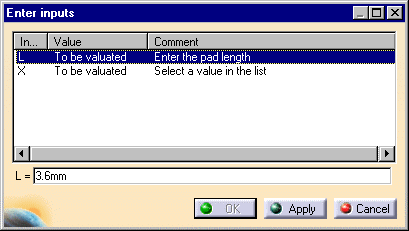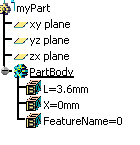
|
|
|
The FeatureName parameter which is a multiple value parameter is created in the specification tree.
You can edit it to check the list of possible values.

Enables you to declare a value to be entered by the end-user. Before the document is generated, a dialog box is displayed and the user is required to enter a value for each piece of data declared as an input.
The Input keyword may be used in two different contexts:
|
If you want a user input to be required, use the following syntax: Input:type_of_the_needed_input Example: Input:Feature or Input:Length or Input:FilePath A user input may be required in the following cases:
|
||||||||||||
|
If you want to re-use a local variable.
Example:
|
Here is the list of data that can be declared as an input:
| Data | type |
| parameter | parameter type as declared in f(x) |
| file paths | FilePath |
| feature names | Name |
| edges when they are used to create features like chamfers or fillets | Edge |
| points when they are used to create holes | Point |
| features | Feature |
| faces | Face |
| axes | Axis |
| length | Length |
DataName = DefaultValue, Input: DataType "Comment"
or
DataName = DefaultValue, Input: DataType In: 'value1,value2,...';
where:
|
|
|
|
|
|
|
When the script below is executed:
myDocument isa
CATPart |
The following dialog box is displayed:
 |
|
||||
| Select one of these values, click Apply then click OK to
execute the script and generate the document. The FeatureName parameter which is a multiple value parameter is created in the specification tree. You can edit it to check the list of possible values.
|
 |